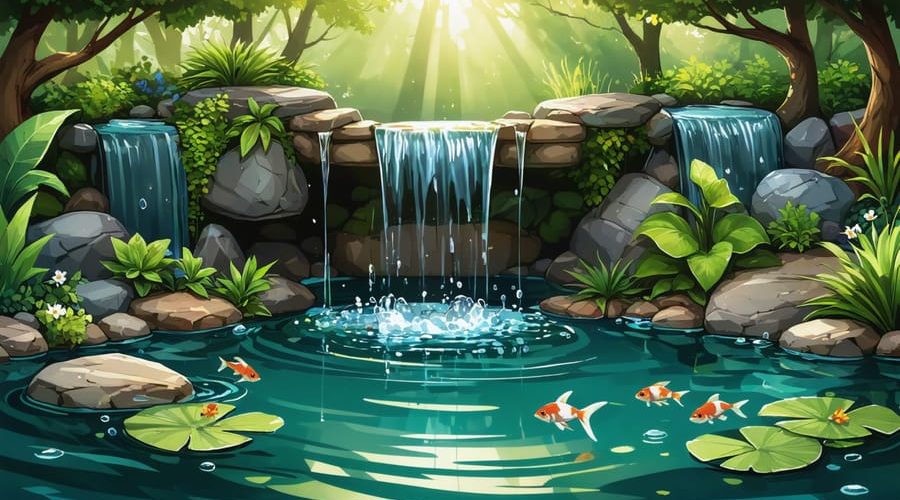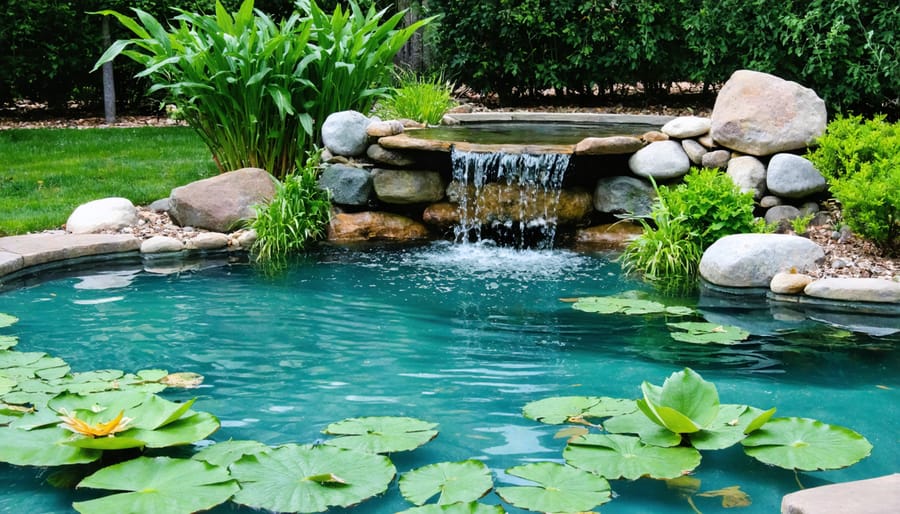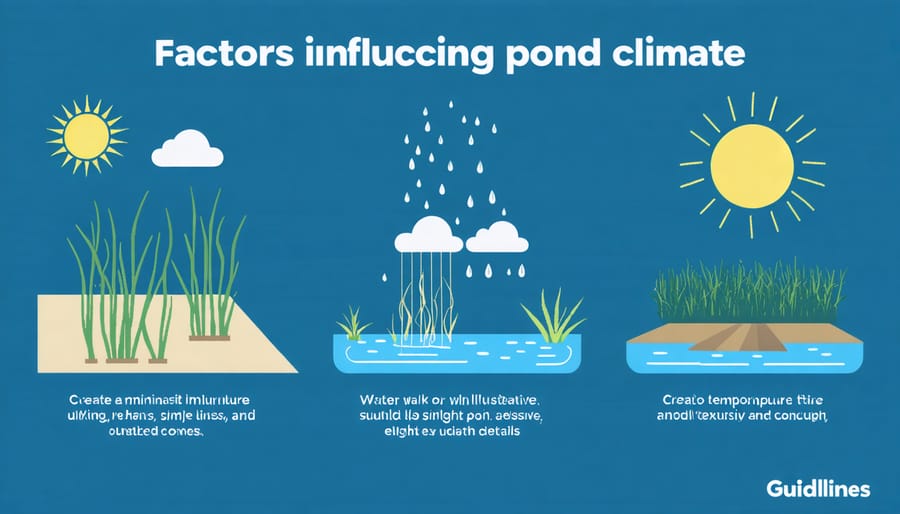
Crafting the Perfect Climate for Your Backyard Pond Paradise
Ponds and lakes are complex ecosystems, their delicate climates shaped by a tapestry of interdependent factors. Temperature, sunlight, nutrients, and biological activity intertwine in an intricate dance, each element playing a vital role in the aquatic ballet. From the still surface to the murky depths, these inland waters pulse with life – algae bloom and fade, fish dart and dive, insects skitter and buzz. Seasonal shifts paint the waters in an ever-changing palette, spring’s vibrant greens giving way to autumn’s golden hues. To understand the climate of ponds and lakes is to glimpse into a microcosm, a world within our world, at once achingly fragile and powerfully resilient. In exploring their secrets, we not only expand our knowledge but also deepen our appreciation for the wondrous complexity of nature’s grand design.
Understanding Pond and Lake Climates

Water Temperature
Water temperature plays a crucial role in pond ecosystems, affecting the health and behavior of aquatic life. In general, pond water temperatures vary seasonally, with warmer temperatures in the summer and cooler temperatures in the winter. The ideal water temperature for most pond inhabitants falls between 65-75°F (18-24°C).
Pond water also exhibits thermal stratification, meaning the temperature changes with depth. The surface layer, or epilimnion, is typically warmer due to sun exposure. The bottom layer, or hypolimnion, remains cooler. In between lies the thermocline, a transition zone where temperature rapidly decreases with depth.
Seasonal temperature changes and stratification affect pond ecology in various ways. Warmer temperatures increase metabolic rates, leading to faster growth and reproduction. However, excessive heat can cause stress and oxygen depletion. Colder temperatures slow down biological processes and may trigger hibernation in some species. Understanding these temperature dynamics helps pond owners create optimal conditions for their aquatic pets and plants throughout the year.
Sunlight Exposure
Sunlight is a crucial factor in the climate of ponds and lakes, as it directly influences water temperature and plant growth. The amount of sunlight a pond receives depends on its location, surrounding vegetation, and the time of year. In general, ponds that receive more direct sunlight will have warmer water temperatures, which can promote the growth of algae and aquatic plants. However, too much sunlight can lead to excessive algae growth and cause the water to become murky. On the other hand, ponds that are shaded by trees or other structures will have cooler water temperatures and may experience slower plant growth. To optimize sunlight exposure, consider the placement of your pond and the surrounding landscape. If you want to encourage plant growth, choose a location that receives at least six hours of direct sunlight per day. If you prefer cooler water temperatures, consider placing your pond in a partially shaded area or adding floating plants to provide shade.

Optimizing Your Pond’s Climate
Shade and Shelter
Providing shade and shelter around your pond is essential for regulating water temperature and protecting pond life. Strategically placing trees, shrubs, or man-made structures can create shaded areas that prevent the water from overheating during hot summer months. This helps maintain a stable environment for fish and other aquatic creatures. Floating plants like water lilies and lotus also provide natural shade on the water’s surface.
In addition to temperature control, shelter offers hiding places for fish and amphibians, shielding them from predators and reducing stress. Submerged logs, rocks, and aquatic plants create a diverse habitat that supports a thriving ecosystem. When planning your pond’s layout, consider the sun’s path and prevailing winds to optimize shade coverage throughout the day.
Incorporating a mix of deciduous and evergreen plants around your pond ensures year-round protection. Remember, striking a balance between shade and sunlight is key to promoting healthy plant growth and maintaining optimal water conditions.
Aeration and Circulation
Pond aerators play a crucial role in maintaining a healthy climate for ponds and lakes. By introducing oxygen into the water, aerators promote beneficial bacteria growth, which breaks down organic matter and reduces sludge buildup. This process helps prevent foul odors and maintains clearer water. Proper aeration and circulation also minimizes the risk of algal blooms by distributing nutrients evenly throughout the water column. Fish and other aquatic life thrive in well-oxygenated environments, as it supports their respiration and overall health. Additionally, aeration helps regulate water temperature by preventing stratification, which can lead to stagnant and oxygen-depleted zones. By investing in a quality pond aerator, you can create a balanced ecosystem that promotes water clarity, reduces maintenance, and enhances the aesthetic appeal of your pond or lake.
Planting for Climate Control
Planting the right vegetation around your pond can significantly impact its climate, creating a more balanced and healthy pond ecosystem. Consider incorporating floating plants like water lilies and lotus, which provide shade and help regulate water temperature. Submerged plants such as hornwort and anacharis are excellent for oxygenating the water, while emergent plants like cattails and rushes help filter nutrients and stabilize the shoreline. Marginal plants, including pickerelweed and arrowhead, add visual interest and provide habitats for beneficial insects and wildlife. By strategically selecting and placing these plants, you can optimize your pond’s climate and create a thriving aquatic oasis.
Seasonal Climate Considerations
Spring and Summer Care
As the weather warms up, your pond will come alive with renewed growth and activity. To keep your pond thriving during spring and summer, maintain good water quality by removing debris and excess nutrients. Skim the surface regularly and remove any accumulated organic matter from the bottom. Consider adding beneficial bacteria to break down waste and maintain clarity. Keep an eye on water levels, topping off as needed to compensate for evaporation. Prune aquatic plants to prevent overgrowth and ensure adequate sunlight penetration. Provide shade for fish during the hottest parts of the day using floating plants or shade sails. Monitor water temperature and use aeration to maintain optimal oxygen levels. Lastly, enjoy the vibrant colors and lush foliage of your pond as it flourishes in the warm sunlight. With a little TLC, your backyard oasis will be the perfect spot to relax and unwind all season long.
Fall and Winter Preparation
As temperatures drop and daylight hours shorten, it’s essential to prepare your pond for the changing seasons. Start by removing any debris, such as fallen leaves, that may have accumulated on the surface or bottom of the pond. This will prevent the debris from decomposing and affecting water quality. Next, trim back any dying or overgrown aquatic plants, which can also contribute to excess organic matter in the water. Consider adding a pond heater or de-icer to maintain a consistent water temperature and prevent the surface from freezing over completely. This will allow toxic gases to escape and oxygen to enter the water, ensuring your fish and other aquatic life survive the winter. Finally, adjust the feeding schedule for your fish, as their metabolism slows down in cooler temperatures. By taking these proactive steps, you’ll help your pond transition smoothly into the colder months and emerge healthy and vibrant come spring.
Monitoring Pond Climate Health
Essential Climate Metrics
To keep your pond or lake thriving, monitor these essential climate metrics: water temperature, which affects oxygen levels and aquatic life; pH levels between 6.5-8.5 for optimal balance; and dissolved oxygen, crucial for fish and beneficial bacteria. Regularly test these parameters using pond thermometers, pH test kits, and dissolved oxygen meters. Aim for consistency and address any imbalances promptly to maintain a healthy ecosystem. Seasonally, track air temperature, sunlight exposure, and precipitation to anticipate changes in water conditions. With attentive monitoring and timely adjustments, you’ll create an ideal climate for your pond’s inhabitants to flourish.
Climate Adjustment Techniques
To maintain a balanced pond climate, monitor water temperature and oxygen levels regularly. Use a pond thermometer and dissolved oxygen meter for accurate readings. If temperatures rise, add shade with floating plants or surrounding vegetation. Install a fountain, waterfall, or aerator to improve oxygen circulation and prevent stagnation. In colder months, use a pond heater to prevent freezing and maintain a small opening in the ice for gas exchange. Regularly remove debris and excess algae to maintain water quality. Consider adding beneficial bacteria to break down organic matter and keep the ecosystem in check. By proactively making these adjustments, you’ll create a stable, healthy environment for your pond’s inhabitants to thrive.
Conclusion
Understanding the climate of your pond or lake is crucial for creating and maintaining a thriving aquatic ecosystem. By monitoring key factors like temperature, oxygen levels, and water chemistry, you can ensure your pond remains healthy and vibrant throughout the seasons. Implementing strategies such as aeration, circulation, and beneficial plantings will help optimize your pond’s climate and support a diverse array of aquatic life. As you nurture your pond and witness its beauty evolve, you’ll develop a deeper appreciation for the delicate balance of nature. Embrace the joys of pond stewardship and watch your backyard oasis flourish under your attentive care.
